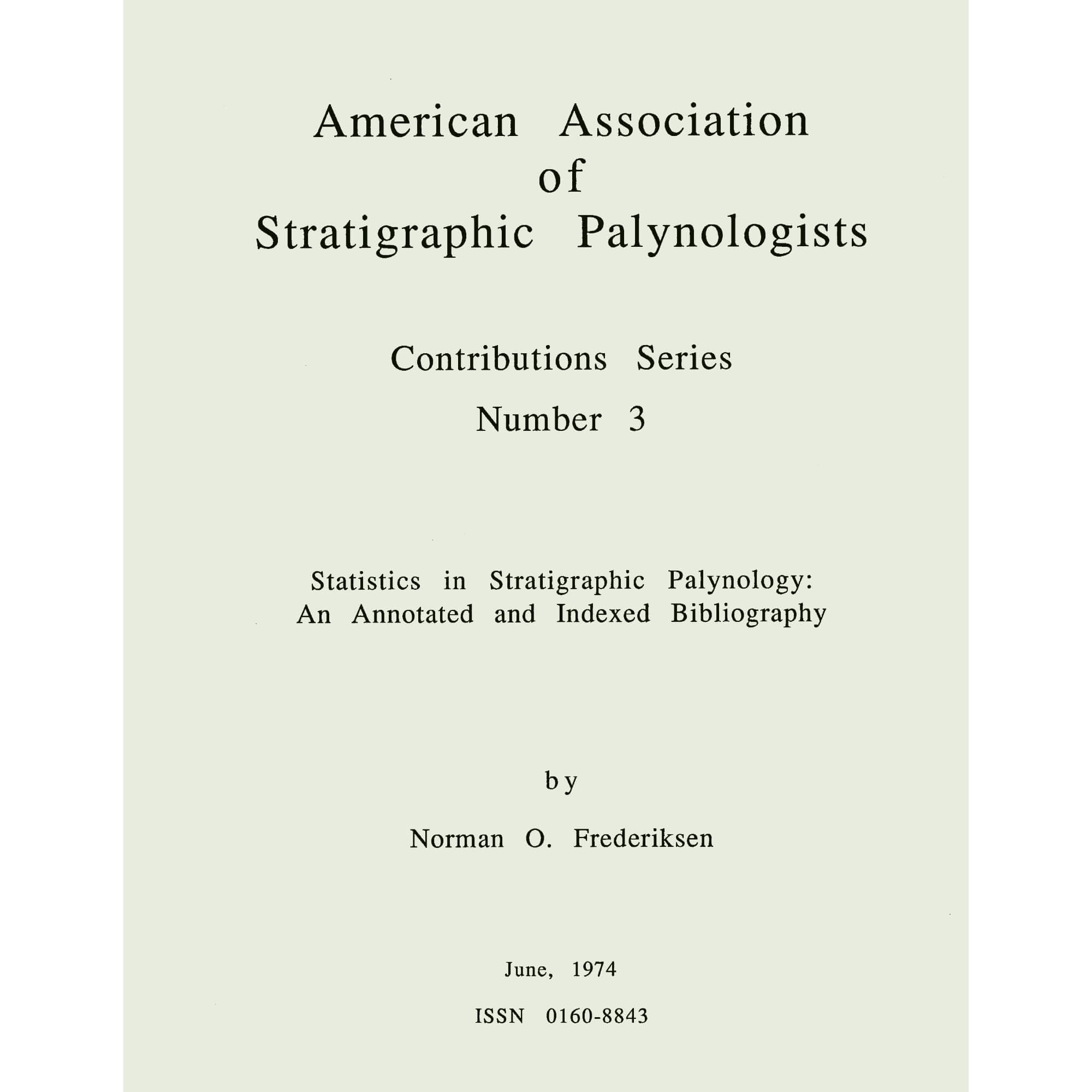Contributions Series Nr. 3
$3.00 – $5.00
Statistics in Stratigraphic Palynology: An Annotated and Indexed Bibliography
Norman O. Frederiksen
1974
PDF only
71 pp.
Description
Author’s Preface
The objectives of this bibliography are to list important papers in which the authors make quantitative analyses of palynological data, especially in solving stratigraphic problems; to summarize the analytical methods used in each paper; and to index the methods, so that one can easily find which papers have used a particular procedure.
The main purpose of each paper’s summary (the annotation) is to list the statistical methods used and briefly to tell why the methods were used. The results of the analyses are not of concern unless they lead to an evaluation of the statistical procedure. The annotations are intended only to be a guide to the literature and to lead the reader to papers of interest.
This bibliography includes 159 annotated references; it is based on a reading or at least a scanning of more than 550 books and papers. It is not intended primarily to be an historical survey of the subject, but rather to be an aid to the palynologist in his everyday work. Therefore the emphasis is on more recent papers, although many older papers are included also. The bibliography is meant to include as many different statistical methods as possible.
No attempt is made to point out errors in the procedures used by authors, but it is. noted if a later paper comments on an earlier one. For instance, in the annotation of Deevey and Potzger (1951), reference is made to these authors’ criticism of Barkley’s (1934) use of correlation coefficients. Similarly, at the end of the annotation of Barkley’s paper, a note indicates that comments on his article are to be found in the paper by Deevey and Potzger.
I have used the words assemblage and spectrum interchangeably; they both refer to the palynomorphs in a sample or a subsample. The.only abbreviations of palynological terms in this bibliography are AP (arboreal pollen) and NAP (nonarboreal pollen).
The title of each paper appears in the original language, except for papers written in Russian, in which case I have given the title in English, followed by a transliteration of the Russian title in brackets. I have annotated the Russian papers in more detail than the others, on the assumption that palynologists generally find it more difficult to read Russian than most other European languages.
There are a number of papers on palynological statistics that do not appear in this bibliography. Webster defines “statistics” as “classified facts … which can be stated in numbers”. Thus, most palynological papers are statistical in the sense that they include relative and (or) absolute frequency data, but most of these papers are not included in the bibliography unless they analyze the frequencies in some quantitative way. Differential preservation of palynomorphs and the choice of the pollen sum may have important effects on relative frequencies that are calculated; I have included a selection of papers on these topics but by no means all of them. Another problem is counts outside the sum, or inverse counts, leading to the calculation of ”overpercentages”. Many authors used this method, especially in the 1930’s, 1940’s and 1950’s. I have included references to the main early papers in which the procedure was developed, as well as all the paper I could find which discuss the statistical validity of overpercentages.
Several branches of palynological statistics have not been treated here, namely analyses of palynomorph morphology (including numerical taxonomy) and analyses of pollen and spore assemblages trapped from the atmosphere. Large numbers of papers have been written on both subjects, and it was not feasible to include these papers in the bibliography. On the other hand, I have included relevant papers (especially from the more recent literature) on pollen analysis of honey; the statistical problems of melittopalynologists are similar to those of stratigraphic palynologists.
No attempt has been made to include papers from paleontology, ecology and other fields of geology and biology although many such papers have applicability to palynological problems. Non-palynological papers are listed only when these papers propose statistics subsequently used by palynologists.
I have included all the papers I could find in which the raw data are given from replicate counts (separate counts of the same slide or of different slides from the same sample), even if the data aren’t analyzed in those papers. By consulting the index, one can find a list of these papers and can thus find abundant data upon which to make further statistical studies. I have tried also to include all the different methods that have been used to determine the absolute frequency of palynomorphs.
There are undoubtedly interesting and important papers which have been omitted from this bibliography. I would be grateful if readers would send me references to these papers, as well as criticisms of the annotations and index. Such references and comments will be most helpful if an updated version of this bibliography is compiled some years hence.
